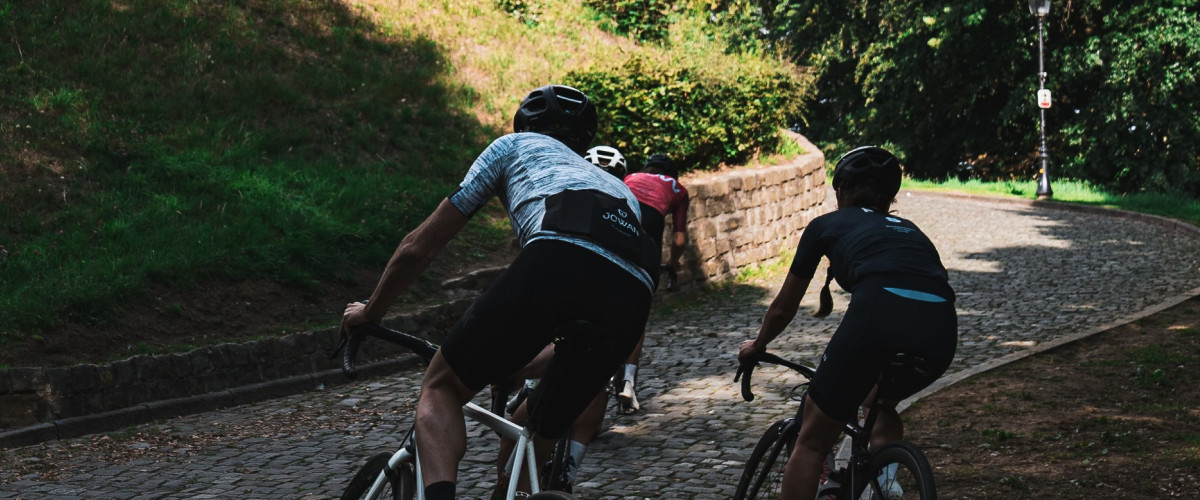The route step by step
Start
This legendary hill has become known as the ‘Edwig Van Hooydonck Hill’ since the famous Flemish cyclist made his race winning move in the Ronde van Vlaanderen there twice, next to the same lamp post, in both 1989 and 1991. The Bosberg is now the final climb in the redesigned Omloop het Nieuwsblad and features three times in the final stage of the BinckBank Tour.
The Bosberg is a wooded slope (average 5.9% and 12% max) between the Flemish Ardennes and the Pajottenland in Geraardsbergen and Galmaarden.
Tenbosse is a climb that wasn't considered one for a long time. A street like many others in Brakel and surroundings. The Tenbossestraat only became Tenbosse after Johan Museeuw proved that the decision in De Ronde van Vlaanderen could also be made there, rather than waiting for the Muur 12km later.
The Valkenberg is legendary amongst the cycling fraternity. This 900m hill has a bit of a sting in its tail. And while the steepest point may only be 15%, it feels much worse as you never seem to make any progress. Fortunately, solace awaits at the top in the form of the café In den hengst.
With an average of 3.7% this is not not the steepest of all climbs nor the most famous but it does boast some lovely atmosphere as you pass between the hedgerows. On the other side of the hill you'll find the much better known Leberg.
This is Greg Van Avermaet's absolute favourite climb. Cyclists label this slope as ‘diabolical’. So be prepared if you want to test things out on your bike. The Berendries was climbed for the first time in the Ronde van Vlaanderen (Tour of Flanders) in 1984.
This is Greg Van Avermaet's absolute favourite climb. Boasting a maximum gradient of "only" 10% it seems to feel harder than it is, perhaps because you can always see exactly where you're going. It's usually encountered reasonably early in professional races, which means it isn't taken full-gas, but that will be of scant consolation as you grind your way up.
This 1.400m long, paved climb is part of Omloop het Nieuwsblad. 3.6% average and 9% max. Be careful on the hard right hand turn to the steep part of the climb... Tiesj Benoot came a cropper there in the 2019 edition.
Also known as 'Langendries', this steep climb (max 16%) has a surface that holds the middle in between cobbles and concrete. The climb made several appearances in Omloop during the time Berendries was closed for resurfacing works.
The 2.260 meter long cobblestone road ‘Paddestraat’ is Flanders’ most well-known cyclist’s ‘scourge’. This present day bone rattler was once part of a Roman ‘Via’ between Boulogne-sur-Mer and Cologne. The Paddestraat became a well-deserved national monument in 1995. Here you will find the ‘Ronde van Vlaanderen Monument’, which lists the names of all Ronde winners since 1973, the year in which the Paddestraat was added to the parcours. The right hand bend after the railway crossing where you enter the cobbles was where Frank Vandenbroucke lost his bid for glory in 1999 after a brave attack with 150km to go in the company of teammate Philippe Gaumont. "Fresh" from a night out in Bruges that lasted until the early hours, Gaumont slid out on the bend and broke his wrist. VDB still managed to take second in the sprint.
The cobblestone section of the Lippenhovestraat is 'only' 1100 m long, and traditionally followed just after the cobbles of the Paddestraat in the finale of Omloop Het Nieuwsblad. These days, it's the first cobbled sector of the new Tour of Flanders route. Time to put the hammer down.
The Kortendries may not have featured in the Tour of Flanders very often, but in 1990 it played a crucial role. World champion Moreno Argentin broke away from the select company of the head pack while the rest hesitated. The finish line was still 35km away. The only rider who took up the Italian’s gauntlet was Rudy Dhaenens. Both remained in the lead but in the sprint, Dhaenens proved no match for the world champion. Eight years later, Rudy Dhaenens was killed in a car accident on the day of the Tour of Flanders. He was on his way to the finish in Meerbeke, where he was to commentate for Eurosport.
The legendary 'Muur van Geraardsbergen' (Grammont Wall) takes you to the 110 meter high summit of the Oudenberg. The 910m long climb has an average and maximum incline of 9% and 20% respectively. For decades De Muur was both the penultimate and decisive climb of the Ronde. Also other races such as the Three Days of De Panne, Omloop Het Nieuwsblad and BinckBank Tour use the hill to separate the men from the boys. Don’t forget to pay a visit to the lovely neo-baroque church on the top of the Kapelmuur, which will be a welcome stop after a 20% steep climb.
The rather dated joke in Geraadsbergen is that there are only three famous walls in the world, Berlin, China and theirs. You can, if you are sure you can get moving again, stop on the very roughest section to pay homage at a poetic tribute to Eddy Merckx or you can take a pause at Bar Gidon on the Market Square, which is festooned with race-worn jerseys and autographs of riders past and present. It is also headquarters to Remco Evenepoel's fanclub.
Finish
Plan your stay
Get the hottest tips and tricks to take on Flanders by bike! When should you visit? Where can you rent a bike? What's the perfect place to stay? Or drink the perfect Belgian beer? Check it out!
Related bucketlists
Epic Stories
Those who adore cycling are bound to collect some great stories. Here they are, or at least some of them.
